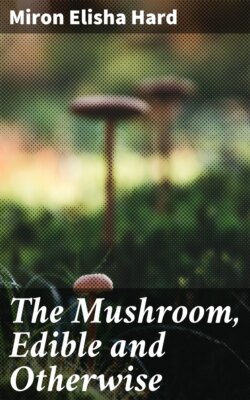Читать книгу The Mushroom, Edible and Otherwise - Miron Elisha Hard - Страница 51
На сайте Литреса книга снята с продажи.
Armillaria mellea. Vahl.
ОглавлениеTable of Contents
The Honey-Colored Armillaria. Edible.
Figure 39.—Armillaria mellea. Two-thirds natural size. Honey colored. Tufted with dark-brown fugitive hairs. Flesh white.
Mellea, from melleus, of the color of honey. Cap fleshy, honey colored, or ochraceous, striate on the margin, shaded with darker brown toward the center, having a central boss-like elevation and sometimes a central depression in full grown specimens, tufted with dark-brown fugitive hairs. Color of the cap varies, depending upon climatic conditions and the character of the habitat. Gills distant, ending in a decurrent tooth, pallid or dirty white, very often showing brown or rust colored spots when old. Spores white and abundant. Frequently the ground under a clump of this species will be white from the fallen spores. Stem elastic and scaly, four inches or more in length. Ring downy. Diameter of cap from two to five inches. Manner of growth is frequently in tufts, and, as with most of the Armillarias, generally parasitic on old stumps.
The veil varies greatly. It may be membranaceous and thin, or quite thick, or may be wanting entirely, as will be seen in Figure 39; in Figure 40 only a slight trace of the ring can be seen. The two plants grew under very different environment; the last grew in the woods and Figure 39 on a lawn in the city. The species is very common and grows either in thin woods or in cleared lands, on the ground or on decaying wood. Its favorite habit is about stumps. It is either solitary, gregarious, or in dense clusters. It is very abundant about Chillicothe, where I have seen stumps literally surrounded with it. It has a slight acridity while raw, which it seems to lose in cooking. Those who like it may eat it without fear, all varieties being edible.
Prof. Peck gives the following varieties:
A. mellea var. obscura—has the cap covered with numerous small black scales.
A. mellea var. flava—has a cap yellow or reddish-yellow, otherwise normal.
A. mellea var. glabra—has a smooth cap, otherwise normal.
A. mellea var. radicata—has a tapering root penetrating the soil.
A. mellea var. bulbosa—has a bulbous base.
A. mellea var. exannulata—has the cap smooth and even on the margin, and the stem tapering at the base.
